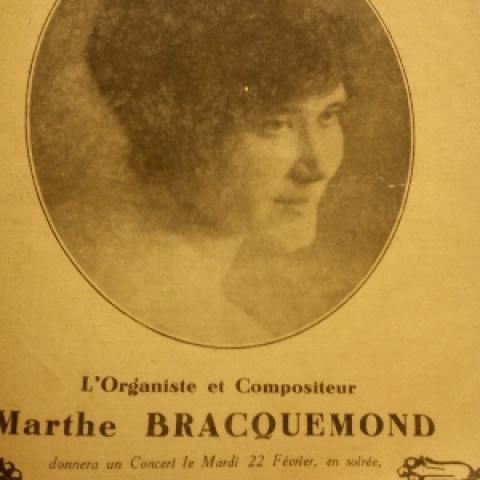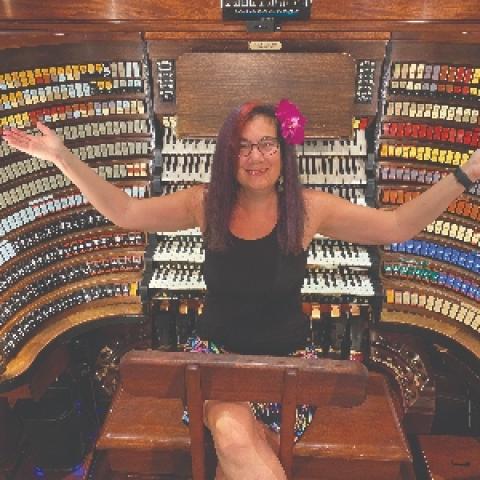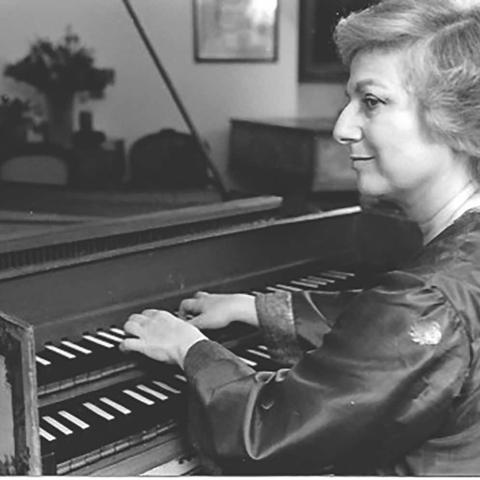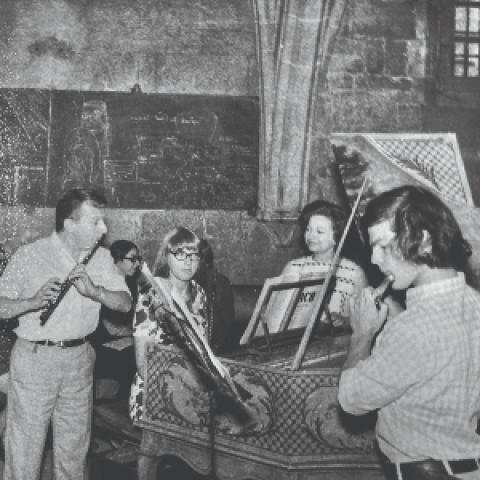Jesse Eschbach is a graduate of Indiana University, Bloomington, and the University of Michigan, Ann Arbor, where he was a student of Robert Glasgow. He completed his formal education during a five-year residency in Paris as a student of Marie-Claire Alain, specializing in early French music in her conservatory class at Rueil-Malmaison where he was awarded both a Prix d’Excellence and a Prix de Virtuosité. As one of the last students of Marie-Madeleine Duruflé-Chevalier, he studied the complete organ works of her husband, Maurice Duruflé, as well as much of the French symphonic repertoire.
Since 1986, Eschbach has served on the faculty at the University of North Texas, Denton, as professor of organ, instructing performance majors at all levels. Eschbach has several CDs to his credit, including a disc recorded at the Cathédrale de Perpignan entitled Music of the Second Empire and Beyond, released in 2003. Also released in 2003 was his 800+ page book, Stoplists of Aristide Cavaillé-Coll, detailing the original stoplists of the majority of organs constructed by this French organbuilder, based extensively on the Lapresté collection. This research is still in progress, and an expanded second edition will be released in the next few years.
Due to focal dystonia in the right hand, his career was sidetracked for more than ten years, but due to the efforts of Dorothy Taubman and Sheila Paige, he has begun resuming his performance career. He has been a juror for several competitions, including the American Guild of Organists national competition, the Canadian International Organ Competition, and the Fort Wayne national competition.
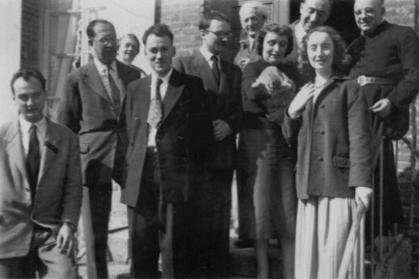
On July 27, 2018, my dear colleagues and friends, Yannick Merlin and Béatrice Piertot, introduced me to Pierre Labric at his residence southwest of Paris in Dreux. Labric is perhaps best remembered in this country for recording the complete organ symphonies of both Widor and Vierne on the legendary Cavaillé-Coll instruments of St-Ouen, Rouen (Widor), and St-Sernin, Toulouse (Vierne). These recordings were marketed in the United States by The Musical Heritage Society after 1971 and introduced my generation to not only the symphonic style of Widor and Vierne, but also the sound universe of Aristide Cavaillé-Coll.
After spending a delightful two and a half hours with Mr. Labric and speaking at great length about his mentor Jeanne Demessieux and his brilliant friend and colleague at the Paris Conservatory, Jean-Claude Touche, I asked Yannick and Béatrice on our return trip to Paris if Mr. Labric might consent to a written interview on the life and achievements of Jeanne Demessieux. Yannick Merlin received an enthusiastic response, and I drafted twenty questions, intending to explore Demessieux’s short but highly eventful life.
Mr. Labric, as the reader will soon observe, was most generous with his responses. He was never limited with any constraints suggested by a particular question, but “improvised” freely in his responses.
Only one question failed to elicit a direct response: I asked if Pierre Labric could confirm what Marie-Madeleine Duruflé-Chevalier recounted years earlier. An incisive attack and release was the core of her legendary virtuosity,1 and she attributed this to her study with Jeanne Demessieux, most especially what Mme Duruflé called the “deuxième mouvement,” or release of a note, which must have at least as much energy and clarity as the attack. This concept goes to the core of brilliant, virtuosic playing, sometimes forgotten today in France and the United States. Both Demessieux and Duruflé were capable of extremely brilliant tempos, yet every note was clearly heard and energetic, regardless of the acoustic. Regrettably, Mr. Labric seems not to have discussed this topic with Jeanne Demessieux, but confirmed, “M-M Duruflé was formed exclusively by Jeanne Demesssieux. In class, Dupré told us with the greatest admiration, ‘My children, see how Jeanne Demessieux is getting results from Marie-Madeleine.’ Yes, it was true.”2
The inevitable question did arise during our meeting in 2018 concerning the traumatic rupture between Dupré and Demessieux. I knew better than to launch “head-on” into this sad story with a French gentleman of Mr. Labric’s generation, always highly discreet. I did repeat what Marie-Madeleine Duruflé confided years earlier, and this elicited a broad smile and unmistakable twinkle of the eye. Given that direct descendants of the principal parties are still with us, and since the cause of the saga can never be proved, I can only repeat what others have said: Jeanne Demessieux was utterly blameless, and Dupré was foolishly victimized and manipulated by individuals in his entourage who intended to overthrow Demessieux to suit their own agenda. It was a veritable plot originating from near unparalleled, despicable jealousy that nauseated everyone in the French organ world and well beyond. Seventy-five years later, condemnation of the injustice perpetrated on the young Jeanne Demessieux continues to resonate. Marcel Dupré enjoyed almost complete authoritarian control of the French organ world and was more than capable of destroying, or otherwise compromising, a promising career.3
Mr. Labric, born in 1921, grew up in the Rouen area and received his early training from Marcel Lanquetuit before admission to Dupré’s class at the Paris Conservatory. His career was largely devoted to recording, resulting in releases of the complete organ symphonies of Widor and Vierne, the complete organ works of Jeanne Demessieux, sonatas of Mendelssohn, preludes and fugues of Saint-Saëns, the major organ works of Liszt, and the Promenades en Provence of Eugène Reuchsel. He was Demessieux’s suppléant at the Madeleine, and also assisted Pierre Cochereau at Notre-Dame Cathedral. As he approaches his centennial, it seemed especially appropriate to begin collecting some of his indelible memories of one of the most eventful epochs in the history of our profession.
Jesse Eschbach: If I remember correctly, Jeanne Demessieux was Marcel Dupré’s assistant in the organ class [at the Paris Conservatory] towards the end of the war. Was it at this time that you met Jeanne Demessieux for the first time? How did she prepare you for the organ class? Technique, repertory, interpretation, counterpoint, harmony, improvisation?
Pierre Labric: Yes, Jeanne Demessieux replaced Dupré in the organ class during the week of May 14–21, 1946. I’m transcribing the themes she had us work on [in improvisation]: What beautiful themes!
That day, she worked quite awhile with me. It was the year I was first runner-up. I believe I remember that she was happy with my improvisation. I attended her overwhelming competition for her unanimous first prize on June 6, 1941. The entire audience broke the law of silence: frenetic and long applause reflected the general enthusiasm. That day, our contact started.
How long did you work with Jeanne Demessieux?
I worked all my life, and I owe everything to Jeanne Demessieux.
At the end of your studies at the conservatory, did you remain in contact with Demessieux?
Yes, and after her appointment to the Madeleine, she asked me to play services in her place. I always remained in cordial contact with her and her dear mother after she became a widow. During a lesson, I asked her if, in the vast nave of a cathedral, one had to moderate tempo a little bit because of the reverberation. “No,” she replied, “It is necessary simply to articulate.”
What repertory did you undertake with Demessieux? Bach, Buxtehude, old French music, Liszt, Franck?
She had me work on her (Six) Études with great interest. They made me progress enormously. I started with the octave study, which I perfected during all of the school year 1948. I played it for her in May, and with her advice I worked on it during [summer] vacation. I played it for her again in September. She was happy with my work, and encouraged me to put it on my program on October 15 at St-Godard, Rouen. I was happy and . . . proud! I got her precious advice for the big Vierne works. I recorded all of them later, observing everything scrupulously. She had me work for part of the afternoon. Madame Demessieux prepared for us, delicately, a delicious snack that we savored with one of my friends who accompanied me to my lesson—she, too, has since passed! All of this downed with a cup of coffee for which I could never replicate the flavor.
“Mama has her little secrets,” Jeanne told us! My modest repertory was Liszt, Franck, Widor, Guilmant, Vierne, Duruflé, very little Litaize, very little Langlais, Jean-Claude Touch, Jean Guillou. A pirated version of my recording of his Toccata from one of my concerts at Saint-Ouen de Rouen is on the internet.
What preparatory studies did the teacher Demessieux want in place before taking a student?
She required a serious piano technique with etudes of Chopin or Liszt.
Did she ask for repertory studied at lessons be memorized?
No. I played all of my lessons with the text.
Could you describe the legendary memory of Demessieux?
For the magazine Étude (April 1950), the editors asked Jeanne Demessieux for an article on Dupré. She wrote fifteen sublime pages in which appeared not a shade of vengeance, not a trace of the least bitterness. The writing has the limpidity of the entire truth. What a marvelous lesson Jeanne Demessieux gave to Dupré.
The Rouen Philharmonic Society, directed by an excellent musician-pianist Pierre Duvauchel, was always running a deficit. Demessieux, who came for a sou, filled the coffers: a half hour before the concert, there wasn’t a chair left in the immense nave!
A poor priest had difficulties keeping his school afloat. He dared to ask Jeanne, then at the top of her international glory, if she would accept to give a concert for a rather low fee. Her secretary responded, “Miss Demessieux asks me to inform you she will offer a free recital for your school. A date has to be found according to her possibilities.” I have read the letter.
You recounted a beautiful anecdote concerning a trip Demessieux made to Normandy, around Deauville, I think. A priest from a little village asked her to visit his parish the day after the concert. What happened when she tried out the organ?
Jeanne Demessieux had given a concert in Deauville on August 27, 1956. You have the review written by Guy Bouchaux, which deserves to be read by everyone.
Verbal program notes were given by the Canon Leprieur, priest of Beuzeville about twenty kilometers away. Demessieux was to return to Paris by car with M. Haerpfer, the builder of the organs in Deauville and Beuzeville, which has a smaller organ.
Abbot Leprieur had invited Demessieux to visit the organ in Beuzeville the next day on her way back to Paris. The grapevine having done its work, about twenty from the audience of the day before greeted Demessieux when she got out of the car. Abbot Leprieur led her to the gallery, followed by the would-be listeners. She got to know in very little time the modest instrument of sixteen stops. She didn’t even need much more time for the giant consoles during her American tours. She went through each stop attentively and was getting ready to leave the keyboards. Abbot Leprieur then said suddenly, “Mademoiselle, would you play the Alain Litanies for us?” Without hesitating, Demessieux gave us a brilliant interpretation of the Litanies. After that, Galérant (in the photo) asked her for the Second Choral of Franck; another asked her for the “Toccata” from the Fifth Symphony of Widor; another suggested a Noël of D’Aquin. “Which one?” she asked simply. After, a gentleman I didn’t know asked for the “Carillon de Westminster.” Others requested several Bach pieces. All of these pieces were at random and not on the program from the day before. She played for two consecutive hours, responding with a perfect humility to the requests of each with the single aim of pleasing. There is the perfect example of a concert “requested by the audience.”
What happened when she tried the organ, you ask me? Nothing!
Jeanne was very reserved, always in perfect control, and also in control of her company. She never felt the need to ask questions. For her, all the problems were worked out ahead. If someone explained to her the reason for something because of this, because of that, she listened very politely, without feeling the need to open her mouth. She remained silent. She was like the diamond who never sought to shine, but was made to shine. She played the organ at Beuzeville most naturally, before several subjugated and privileged people, enthusiastic and astonished by such natural facility.
Jeanne was radiant taking leave of her improvised admirers. And we went to lunch at the rectory, as the photo attests, taken by the young curate of the parish when we arrived. Sixty-two years ago! Jeanne made a very quiet “impact,” yet strongly powerful, felt by everyone around her. Her rich personality radiated naturally without being conscious of it, so it seemed.
Monsieur Albert Dupré, father of the Dupré in question, was organist of the magnificent Cavaillé-Coll of Saint-Ouen de Rouen—“Orgue à la Michel-Ange” according to the famous estimation of Widor who came to inaugurate it. On the occasion of the first concert of Jeanne’s at Saint-Ouen, hearing about it, Dupré supposedly exclaimed, “Imagine, she dared play Papa’s organ!” The clumsy remark eventually got back to Jeanne Demessieux who spontaneously retorted, “Oh, Papa had nothing to complain about!”
She was very humorous.
I don’t think we have many recordings of Demessieux’s improvisations. Could you tell us about her style in improvisation? Did she often improvise in established forms such as sonata-allegro, fugue, double fugue, lied, variations, passacaglia, etc., or was she rather free?
During her concert tours in America, Miss Murtagh4 called Jeanne Demessieux, pointing out a day when Jeanne wasn’t on time. She scolded her on the telephone like a little girl. With her usual calm, her natural distinction, her nobility of a great lady, Jeanne Demessieux responded simply with, “Madam, I always5 do what I want,” cutting off any response. Many organists do what they can, starting with me! At the keyboard, Demessieux always did what she wanted. Her magnificent recordings are the proof!
As for her improvisations, if they were always inspired (again, she did what she wanted), they all were adapted to the character of the given theme. I heard her improvise many a time, the very first being her conservatory competition on June 6, 1941. The luminous cadenzas of the first two concertos of Handel were improvised before being written down and recorded on the Decca label. The first one astonished Guy Bouchaux at her concert in Deauville on August 27, 1956, as well as her improvisation on In Paradisum.
I recall yet today her extraordinary symphonic fresco on the Kyrie Orbis factor given to her by Fr. Boulzy at the end of her concert on November 7, 1953, at Saint-Eustache. She finished with a prodigious fugue. The large audience, which filled the nave, was cosmopolitan: French, Italians, Germans, English, Americans, Japanese applauded discretely when she came down from the gallery.
Examples are numerous and deliciously fascinating. I’ll limit myself to several: I heard Demessieux improvise at Saint-Ouen. For her, to improvise was to abandon herself to her rich and inspired imagination at the end of a concert. The mind free, on a magnificent instrument she loved, developing a very beautiful theme given to her by Maurice Duruflé, I remember elegant variations faithfully ornamenting the theme under the sumptuous sonorities of the “Cavaillé-Coll à la Michel-Ange,” which she knew how to transfigure like no one else.
To your question, I don’t know about recordings of her improvisations with the exception of the one on the Hamburg CD, The Legendary Jeanne Demessieux, done in several churches in Hamburg: St-Sophiekirche, St-Michaelskirche, St-Christianskirche on the label Festivo, 6961-862. Many years ago, I was fortunate to hear her splendid improvisations during her legendary concerts in the Netherlands.
M. Van der Oter, deceased, and his colleague Mr. Herman van Vliet, an excellent organist, played for me a magnificent improvisation in Masslouis, which I would ardently like to hear again, and another one, in the Netherlands, the given theme of which lended itself to rondo form, three refrains and three couplets. This quarter hour of true music was so perfect that it made me think of the truly vivid “Rondo Final” of the magnificent Fifth Symphony of Louis Vierne. Regrettably, I never heard either one again!
I found in the archives of Norbert Dufourcq a detailed study of the Madeleine organ written in 1965 by Jeanne Demessieux. This document attests to the fact that Demessieux had a great deal of expertise in organbuilding and especially on the style of Cavaillé-Coll. Dupré, as far as I know, didn’t teach these things to his students. How did Demessieux acquire this knowledge?
To your inquiry, I am going to offer the truest, most exact, most pertinent, the simplest response there is, that of Jeanne Demessieux herself:
I wrote to the periodical L’Orgue that I was waiting and hoping for the organ of the twentieth century:6 an intelligent synthesis, yet original in its audacity, of instruments from the past. In the absence of which, the promoters of neo-classicism will be burdened with the heavy responsibility of having implicitly condemned all7 organ repertory from Bach to the present. The works of Messiaen, Langlais, and others call for a complete radiance in sound where everything is possible.
These thoughts, harbingers of light and wisdom, are a veritable gospel of truth and for all time. And here is a striking aspect of Jeanne Demessieux.
Appointed titular organist of the beautiful Cavaillé-Coll of the Madeleine in 1962, where she succeeded Edouard Mignan, she was keenly interested in the preservation of her instrument. She watched jealously over its esthetic. Her keen awareness of eclecticism, fed by multiple experiences collected over all continents, gave her the ability to compare organs of different characters—following faithfully the evolution of building, with prudence and especially wisdom, while strongly opposing certain displeasing trends.
Her searching spirit always involved a curious look towards the future, without denying the lessons from the past. Her perfectionist and innovative spirit researched unceasingly balance and truth. Her art was enriched with a lofty spirituality. Her enthusiastic listeners perceived her marvelous message with a quieted serenity while others, more receptive, caught a glimpse of her in the light.
Did she have American students? I know that Frank Speller8 went to study with her, but did she have others?
I don’t know.
You mentioned her Te Deum. If I understood you correctly, this work was finished in Demessieux’s mind well before she wrote it down?
Your assertion is absolutely exact. The brutal and sudden rupture with Dupré, never understood by poor Jeanne Demessieux, necessarily accentuated her timidity and humility that were already the basis of her exceptional personality. “I never talk about my plans,” she responded to an overly gushing interlocutor.
At her concert in Deauville, I asked her discretely if she would soon give us the joy of a new work. “Yes,” she answered spontaneously. “I am thinking of writing a work in the spirit of the chorals of Franck on the Te Deum.” Overwhelmed, I didn’t push further, being content with this detail, so affectionately confided, I being one of the rare individuals—if not the only—to know the gestation of the most beautiful of the Te Deums. No reference concerning what I knew to be a serious confidence would be brought back to her, at least coming from me.
The streets of Rouen were all decked out with giant posters as if to announce the visit of the Queen of England: “Jeanne Demessieux on her return from America.” She returned from a big concert tour, during which she had played her Te Deum, not yet published, but for which I didn’t know the reason. It was on the program for April 30, 1958. That’s when I heard it for the first time, next to her, in the afternoon. I was astonished by the grandeur and the beauty of the work. It is impossible to find more moving accents to praise God. I asked her if she would consent to loaning me her manuscript. “But no, dear Pierre, I haven’t yet had time to write it down!” My eyes popped out of my head before such prowess that I never would have imagined. I remained speechless.
In matters of interpretation, did she use rubato or rather subtleties of touch, or a combination of both?
Jeanne Demessieux had an incredible phrasing. In the chorale preludes of Bach, she used two different cornets, which offered an agreeable echo effect. She played certain works with a surprising slowness, but never gave the impression of dragging.
She played quick tempos with an absolute mastery, a ravishing lightness. Listen to her in the delicious scherzo of the Grande Pièce Symphonique of César Franck where she excelled, in order to be convinced of the perfection found in her recording of the complete organ works of Franck, which came out in 1961.
Jeanne Demessieux never stopped being a pianist. She had her [first] prize when she was 17. She brought her extraordinary technique to the organ. At one of her concerts I attended with my friend Marie-Claire Alain, at the end Alain told me, “You know, it’s magnificent! One really feels she’s a first prize in piano!” I responded, “It’s obvious. I agree with you.” Such was my total approbation.
The complete works for organ of César Franck recorded at the Madeleine in 1959 reveal interpretations where virtuosity is often highlighted. I’m thinking, for instance, of the allegros in the Grande Pièce Symphonique. As far as I know, only her student Marie-Madeleine Duruflé-Chevalier played Franck like that. More than fifty years after these recordings first appeared, metronomic indications written by Franck himself were discovered in a letter addressed by Franck to an American organist,9 which tends to demonstrate that such virtuosity wasn’t at all scorned by César Franck. Jeanne Demessieux, it would seem, was right. Did she talk about these interpretations and her very personal ideas on the subject of Franck’s music?
Jeanne Demessieux revealed Franck like no one else, a recording of reference. What can I add?
Mr. Labric, you are perhaps the last to have often played the authentic Cavaillé-Coll of Notre-Dame, Paris,10 before the reconstruction and electrification in the 1960s. I would like very much if you would talk about this legendary instrument before the transformations occurred.
“My alter ego,” said Vierne speaking about his Cavaillé-Coll at Notre-Dame, Paris. Nothing better than these words could translate the nature of the emotional attachments that bound together one to the other. This was affirmed by Bernard Gavoty. Gavoty continued, “as the flower breaks loose from its sheath, the song swells and spreads forth. With his hands, the musician sculpts his work in a sonorous clay of which nothing can evoke the voluptuous richness. The entire organ seems to stir in contact with this soul that brings it to life.”
The organ of Notre-Dame de Paris was the absolute masterpiece of Cavaillé-Coll. In the fingers of Vierne, it offered a unique splendor. A musician from Rouen, André Haumesser went from time to time to the gallery of Notre-Dame to hear Vierne. He mixed in with the regulars, and at the instant Vierne was preparing to improvise, one of them said, “Let us listen to the word of Saint Thomas d’Aquin.”
I had the good fortune to often play the magnificent Cavaillé-Coll, admired throughout the world. I remember my first contact which left an indelible feeling. Léonce de Saint-Martin,11 a very distinguished and courteous man, welcomed me one evening after the cathedral closed, allowing me to play the second symphony of Vierne. From the first chord, I was veritably transported in the instant in an ethereal world by this river of sound that flowed under my fingers. The solo stops were ravishing in the following movements up to the sparkling “Final” in which the unique tutti of the instrument seemed indeed to want to explode the shell of the cathedral, as Gavoty wrote. But this prodigious power had nothing of any harshness. Rather, it was part of the incomparable splendor of the organ.
One Sunday of the Holy Trinity, Saint-Martin let me play Dogme, the fourth movement of Méditation sur le Saint-Esprit of Jeanne Demessieux, at the end of vespers. I was happy. This was still at the time of the old [mechanical] console.
Later, I gave Sunday concerts on the new electric console of Jean Herman, which worked very well. It was worthy of the consoles of Beuchet-Debierre. This console permitted me later to record very conveniently the Six Études of Demessieux, which require a perfectly regulated pedalboard.
I had the joy of playing six Sundays, the substitute for Pierre Moreau,12 a very courageous man, recovering from surgery. I arrived Saturday evening. I had almost three hours. For my pleasure alone, I played the six symphonies of Vierne on the instrument that had inspired them. What an unforgettable emotion. Léon Bloy called the royal Cavaillé-Coll, “The organ of eternity.”
I took advantage of these occasions that came my way, I can say by chance, to play at the closing voluntaries, a finale from the Vierne symphonies for the greatest joy of a group of young musicians gathered around the console.
§
As Pierre Labric approaches his centennial, I am certain my American colleagues join me in wishing Mr. Labric every joy and happiness. He is, after all, one of the last remaining figures to have witnessed the joys, triumphs, trials, and tribulations of the legendary organ class at the Paris Conservatory during the post-war period. His recollections help us approach those years with a far deeper understanding of the legendary names that shaped my generation and beyond. Thanks, Pierre Labric, for sharing your pristine memory and impressions of an era that now seems so very distant to most of us. Most of all, thanks for transmitting the legacy of the legendary Jeanne Demessieux to future generations.
Notes
1. Derived from the traditional French harpsichord and piano “schools” where the fingers do most of the work. Arm weight, and arm movements in general, were not introduced at the conservatory until after World War II, although some French pianists were very aware of (and advocated) arm weight and arm movements before 1946.
2. Visit www.organ.music.unt.edu for a video of Mme Duruflé at the University of North Texas auditorium console filmed in February 1992, playing a segment of the Vierne Naïades and a Handel concerto. Although she never knew or consulted Dorothy Taubman, the core of Mme Duruflé’s virtuosity is derived in large part from the same precepts learned by and passed on through the great technician who was Dorothy Taubman: long fingers moved from the short extensor muscles, and very subtle forearm rotations, up-down movement, in-out movements, and lateral shifting of the arm when required by the music.
3. Lest the reader assume that I have migrated to the almost rabid, anti-Dupré groups prominent in France today, such is not the case. My students perform probably more Dupré works than any other studio in North America. My admiration for Dupré as a virtuoso and composer is unbounded, but from what I have learned from his students and others, he was a bit of a dictator and often poorly advised by members of his entourage. Jeanne Demessieux was not the only artist whose career was almost sabotaged by Marcel Dupré.
4. Lilian Murtagh (1907–1976) originally managed concert organists and others for the LaBerge and Colbert agencies before purchasing the organ division from Henry Colbert and forming her own management for organists in 1962. In 1976, her organization merged with Karen McFarlane to create Murtagh-McFarlane Artists Management. Jeanne Demessieux’s three North American tours (1953, 1955, 1958) were organized by Lilian Murtagh.
5. Underscored by Labric.
6. Underscored by Demessieux.
7. Underscored by Demessieux.
8. Frank Speller (1938–2017), former professor of organ at University of Texas for more than forty years, studied with Jeanne Demessieux in Paris sometime during the 1960s. He was one of the few American organists to study with her.
9. Rollin Smith, “César Franck’s Metronome Marks: From Paris to Brooklyn.” The American Organist, September 2003, 58–60.
10. Aristide Cavaillé-Coll finished his 86-stop masterpiece in 1868, inaugurated March 6 of that year by Franck, Chauvet, Guilmant, Widor, Saint-Saëns, Durand, and Loret. The organ was rebuilt and electrified in the 1960s.
11. Léonce de Saint-Martin (1886–1954) succeeded Louis Vierne as titular organist of Notre-Dame de Paris in 1937.
12. Pierre Moreau (1907–1991) served at Notre-Dame de la Gare, Paris, before his appointment to Saint-Marcel, Paris, 1935–1985, and was Saint-Martin’s suppléant at Notre-Dame. Under Pierre Cochereau, Moreau was promoted organiste adjoint, retiring in 1986. He studied with Charles Tournemire for five years and was awarded a first prize in organ in 1938 at the Conservatoire Royal de Bruxelles.


